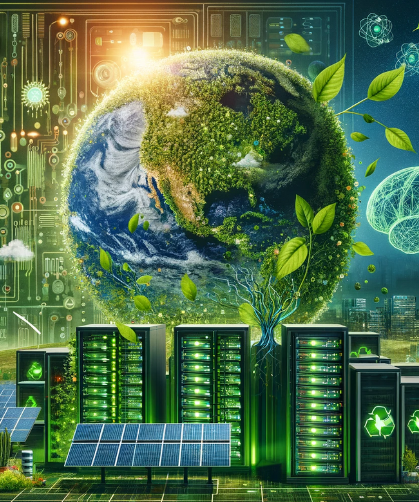As energy demands continue to grow, the push for sustainable energy solutions has never been more urgent. The need for cleaner, more efficient power sources is increasing, and advancements in technology are playing a key role in meeting this challenge. In 2025, we are seeing the emergence of new green energy technologies that are not only addressing rising energy consumption but are also helping drive the transition to a sustainable future. Let’s explore some of the most exciting trends in green energy today.
AI’s Growing Energy Demands and Its Impact on Green Energy
Artificial intelligence (AI) is revolutionizing industries across the globe, but its energy demands are rising at an unprecedented rate. The energy required to power AI technologies, particularly data centers, is expected to strain existing infrastructure. By 2030, data centers alone are projected to consume up to 35 GW of power, necessitating sustainable energy solutions and efficient cooling technologies.
As AI continues to expand, the energy needs of semiconductor chip manufacturing also grow. The U.S. government has recognized this challenge, investing billions in companies like Intel and Samsung Electronics to boost chip production. To keep up with the rising demand, the green energy sector must innovate and provide scalable, sustainable energy solutions that meet the needs of this burgeoning industry.
Emerging Trends in Alternative Energy
Nuclear and geothermal energy have gained significant attention in 2025 as potential carbon-free energy sources. Microsoft recently signed a 20-year power purchase agreement to buy carbon-free electricity from Constellation Energy’s Unit 1 reactor at Three Mile Island, which is set to resume operation. This agreement highlights the growing role of nuclear energy in the transition to sustainable power.
Additionally, startups like X-energy are leading the way with innovations in small modular reactors (SMRs), such as the Xe-100, which promise to be safer and more efficient than traditional nuclear reactors. These developments, combined with advancements in geothermal energy, present a promising future for clean, reliable energy production.
To support this energy boom, efficient cooling methods are also crucial. Liquid cooling, which outperforms traditional air cooling, is emerging as a solution to manage the heat generated by AI technologies and high-performance data centers.
The Green Revolution of Electric Vehicles
Electric vehicles (EVs) are one of the most significant advancements in the fight against climate change. By reducing CO2 emissions compared to traditional gasoline-powered vehicles, EVs are already making a substantial impact. However, the real question is what energy source should be used to charge these vehicles. Solar energy, with its clean and renewable electricity, is the perfect complement to electric transportation.
The synergy between electric cars and solar power offers several benefits:
- Carbon Reduction: Combining solar energy with EVs creates a nearly carbon-free transportation solution.
- Energy Independence: Solar power allows EV owners to charge their vehicles without relying on the grid.
- Cost Savings: Producing your own solar energy for charging reduces expenses in the long term.
Solar-powered EVs not only provide an environmentally friendly solution but also help mitigate the impact of power outages, ensuring a steady energy supply even at night. With battery technology improving, EVs are expected to become even more efficient, and the expansion of charging infrastructure will make them more accessible to consumers.
The Rise of Green Software in Energy Management
As the demand for sustainable energy solutions grows, so does the need for efficient energy management. Green software is emerging as a powerful tool in this space, helping businesses optimize energy usage, reduce fuel consumption, and integrate renewable energy sources.
Leading companies in the energy sector, including Alstom, Schlumberger, and Halliburton, are investing in advanced software solutions to improve operational efficiency. These systems help automate grid management, mitigate risks, and enhance overall performance. The key to success in this area is developing software that aligns with sustainability goals and drives energy optimization across the board.
Green software is designed with scalability and efficiency in mind. It’s not just about improving traditional software; it’s about creating tools that prioritize sustainability, ensuring that energy systems can adapt to future demands while minimizing environmental impact.
Conclusion
The future of energy is being shaped by innovations in AI, electric vehicles, and green software, all working together to meet the growing global demand for clean and sustainable energy. As AI continues to expand and energy consumption rises, the need for renewable energy solutions, like nuclear and geothermal power, will become increasingly important.
Moreover, the ongoing development of electric vehicles, along with advancements in solar energy and battery technology, promises to further reduce carbon emissions and help combat climate change. Green software will play a crucial role in optimizing energy usage, enabling businesses to improve efficiency while minimizing environmental impact.
The success of the green energy transition will depend not only on technological advancements but also on supportive public policies. Leaders in the industry must be able to innovate and adapt to the digital era, ensuring that sustainable energy solutions continue to evolve and meet the challenges of a rapidly changing world.



